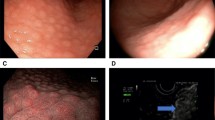Abstract
Chronic atrophic gastritis can be induced eitherby H. pylori or by an autoimmune process. The proteinproduct of bcl-2, which is a protooncogene, blocksapoptosis. Aberrant bcl-2 expression has been found in 68% of atrophic gastritis patients. The aimof this study was to compare bcl-2 expression in 20autoimmune atrophic gastritis patients to that in 20 H.pylori-associated atrophic gastritis patients. Twenty patients with H. pylori antral gastritisbut without atrophy served as controls. The bcl-2expression was assessed by immunohistochemical stainingof gastric biopsies, using mouse anti-human bcl-2 monoclonal antibodies. Autoimmune atrophicgastritis patients were younger, mainly females, with asignificantly higher serum gastrin level than the H.pylori-associated atrophic gastritis group (P < 0.001). The bcl-2 was expressed in 10/20 (50%)of autoimmune atrophic gastritis patients, in 9/20 (45%)of H. pylori-associated atrophic gastritis patients (P= 0.73), and in 2/20 (10%) of controls. There was no correlation between bcl-2expression and the presence of intestinal metaplasia (P= 0.35). Our findings confirm that H. pylori-associatedatrophic gastritis and autoimmune atrophic gastritis are two different conditions, but with equalexpression of bcl-2. Excessive expression of bcl-2 isfound only in atrophic gastritis, but not in H. pyloriantral gastritis without atrophy.
Similar content being viewed by others
REFERENCES
Kuipers EJ, Klinkenberg-Knol EC, Vandenbroucke-Grauls CMJE, Appelmelk BJ, Schenk BE, Meuwissen SGM: Role of Helicobacter pylori in the pathogenesis of atrophic gastritis. Scand J Gastroenterol 32( suppl 223):28–34, 1997
Toh B-H, Van Driel IR, Gleeson PA: Pernicious anemia. N Engl J Med 337:1441–1448, 1997
International Agency for Research on Cancer: IARC Monographs on the Evaluation of the Carcinogenic Risks to Humans, Vol 61, Scistosomes, Liver Flukes and Helicobacter pylori. Lyon, 1994
Forman D, Newell DG, Fullerton F, Yarnell JWG, Stacey AR, Wald N, Sitas F: Association between infection with Helicobacter pylori and risk of gastric cancer: Evidencefrom a prospective investigation. BMJ 302:1302–1305, 1991
Parsonnet J, Friedman GD, Vandersteen DP, Chang Y, Vogelman JH, Orentreich N, Sibley RK: Helicobacter pylori infection and therisk of gastric carcinoma. N Engl J Med 325:1127–1131, 1991
Nomura A, Stemmermann GN, Chyou PH, Kato I, Perez-Perez GI, Blaser MJ: Helicobacter pylori infection and gastric carcinoma among Japanese Americans in Hawaii. N Engl J Med 325:1132–1136, 1991
Forman D, Webb P, Parsonnet J: Helicobacter pylori and gastric cancer. Lancet 343:243–244, 1994
Bronner MP, Culin C, Reed JC, Furth EE: The bcl-2 protooncogene and the gastrointestinal epithelial tumor progression model. Am J Pathol 146:20–26, 1995
Lauwers GY, Scott GV, Hendricks J: Immunohistochemical evidence of aberrant bcl-2 protein expression in gastric epithelial dysplasia. Cancer 73:2900–2904, 1994
Lauwers GY, Scott GV, Karpeh MS: Immunohistochemical evaluation of bcl-2 protein expression in gastric adenocarcinomas. Cancer 75:2209–2213, 1995
Krajewska M, Fenoglio-Preiser CM, Krajewski S, Song K, Macdonald JS, Stemmerman G, Reed JC: Immunohistochemical analysis of bcl-2 family proteins in adenocarcinoma of the stomach. Am J Pathol 149:1449–1457, 1996
Dixon MF, Genta RM, Yardley JH, Correa P: Classification and grading of gastritis: The updated Sydney system. Am J Surg Pathol 20:1161–1181, 1996
Negrini R, Lisato L, Zanella I, Cavazzini L, Gullini S, Villanacci V, Poiesi C, Albertini A, Ghielmi S: Helicobacter pylori infection induces antibodies cross-reacting with human gastric mucosa. Gastroenterology 101:437–445, 1991
Appelmelk BJ, Simoons-Smit I, Negrini R, Moran AP, Aspinall GO, Forte JG, De-Vries T, Quan H, Verboon T, Maaskant JJ, Ghiarra P, Kuipers EJ, Bloemena E, Tadema TM, Townsend RR, Tyagarajan K, Crothers JM Jr, Monterio MA, Savio A, De-Ggraaff J: Molecular mimicry between Helicobacter pylori lipopolysaccharide and host Lewis blood group antigens. Rolein autoimmunity. Infect Immun 64:2031–2040, 1996
Genta RM: Helicobacter pylori, inflammation, mucosal damage, and apoptosis: pathogenesis and definition of gastric atrophy. Gastroenterology 113:S51–S55, 1997
Moss SF, Calam J, Agarwal B, Wang S, Holt PR: Induction of gastric epithelial apoptosis by Helicobacter pylori. Gut 38:498–501, 1996
Barinaga M: Cell suicide: By ICE, not fire. Science 263:754–756, 1994
Rights and permissions
About this article
Cite this article
Maor-Kendler, Y., Gabay, G., Bernheim, J. et al. Expression of bcl-2 in Autoimmune and Helicobacter pylori-Associated Atrophic Gastritis. Dig Dis Sci 44, 680–685 (1999). https://doi.org/10.1023/A:1026641204860
Issue Date:
DOI: https://doi.org/10.1023/A:1026641204860




